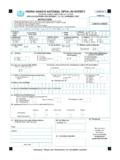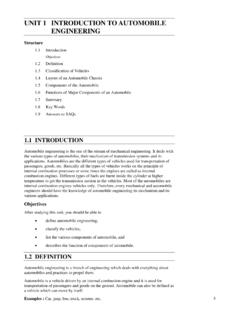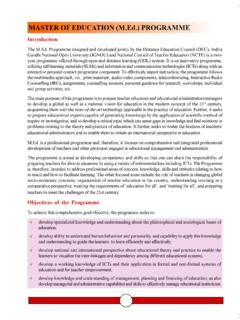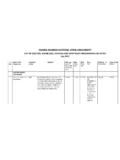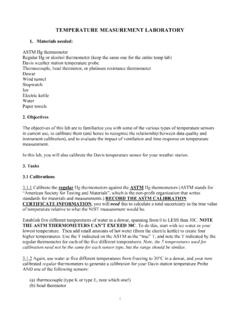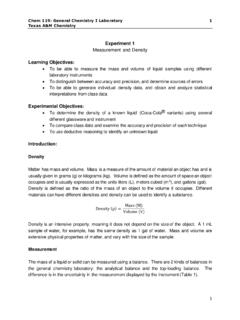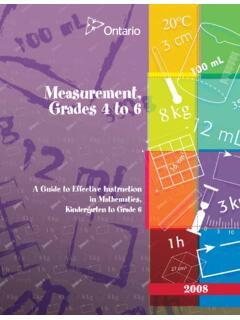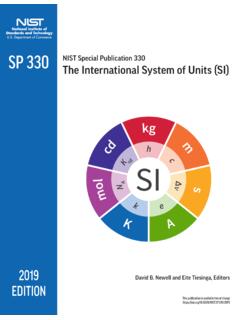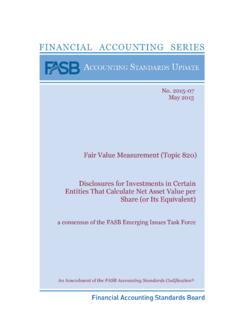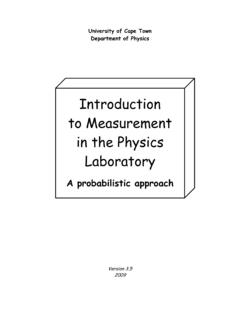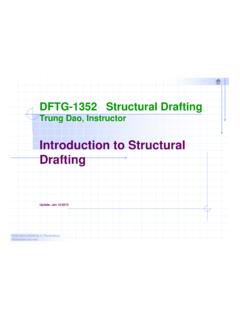Transcription of UNIT 1 STANDARD OF MEASUREMENT Standard of
1 5 STANDARD of Measurements unit 1 STANDARD OF MEASUREMENT Structure Introduction Objectives standards of Measurements and their Classification Primary STANDARD Secondary STANDARD STANDARD unit of Length STANDARD unit of Weight STANDARD unit of Time STANDARD unit of Temperature STANDARD Units of Luminous Intensity of a Source of Light STANDARD unit of Amount of Substance STANDARD unit of Electrical Quantities Summary Key Words Answers to SAQs INTRODUCTION In order that the investigators in different parts of the country and different parts of world may compare the results of their experiments on a consistent basis, it is necessary to establish certain STANDARD units of length, weight, time, temperature and electrical, quantities.
2 The National Bureau of standards has the primary responsibility for maintaining these STANDARD in the United States. In India, Indian STANDARD Institute (ISI), New Delhi has taken the responsibility for maintaining all the STANDARD measurements. To monitor the STANDARD of measurements, the same Institute issues instructions to put ISI mark on measuring instruments and items so that these may be compared with non- STANDARD ones. In the MEASUREMENT system, the quantity to be measured, in the direct method, is compared directly against a STANDARD of same kind of quantity.
3 The magnitude of quantity being measured is expressed in terms of a chosen unit for the STANDARD and a numerical multiplier. A length can be measured in terms of meter and a numerical constant. Thus, a 10 meter length means a length ten times greater than a meter. Thus, by the means of STANDARD , it is possible to provide means of establishing and maintaining the magnitudes of the various units. The simplest kind of STANDARD is a physical object having desired property. This STANDARD can be used as a basis of comparison. Objectives After studying this unit , you should be able to understand the importance of STANDARD in the MEASUREMENT systems, explain the sources and causes of errors in the measurements, and perform the analysis of experimental data to find the accuracy, precision and the general validity of the experimental results.
4 6 Metrology and Instrumentation standards OF MEASUREMENTS AND THEIR CLASSIFICATION The standards of measurements are very useful for calibration of measuring instruments. They help in minimizing the error in the MEASUREMENT systems. On the basis of the accuracy of MEASUREMENT the standards can be classified as primary standards and secondary standards . Primary STANDARD A primary STANDARD quantity will have only one value and it is fixed. An instrument which is used to measure the value of primary STANDARD quantity is called primary STANDARD instrument.
5 It gives the accurate value of the quantity being measured. No pre-calibration is required for this instrument. It is used to calibrate the instruments having less accuracy. By comparing the readings of the two instruments, the accuracy of the second instrument can be determined. Secondary STANDARD The value of the secondary STANDARD quantity is less accurate than primary STANDARD one. It is obtained by comparing with primary STANDARD . For MEASUREMENT of a quantity using secondary STANDARD instrument, pre-calibration is required.
6 Without calibration, the result given by this instrument is meaningless. Calibration of a secondary STANDARD is made by comparing the results with a primary STANDARD instrument or with an instrument having high accuracy or with a known input source. In practical fields, secondary STANDARD instruments and devices are widely used. Using calibration charts, the error in the MEASUREMENT of these devices can be reduced. STANDARD unit OF LENGTH The meter is considered as one of the fundamental unit upon which, through appropriate conversion factors, the English system of length is based.
7 The SI unit of length in metre. The STANDARD metre is defined as the length of a platinum-iridium bar maintained at very accurate conditions at the International Bureau of Weights and Measures at Sevres, near Paris, France. All other metres had to be calibrated against the metre. The conversion factor for length for English and Metric systems in the United States is fixed by law as 1 meter = inches Secondary STANDARD of length is maintained at the National Bureau of standards for calibration purposes. In 1960, the general conference on weights and measures defined the STANDARD meter in terms of the wavelength of the orange-red light of a krypton-86 lamp.
8 The STANDARD meter is thus 1 meter = 1,650, wavelengths of orange-red light of Krypton-86 In 1982, the definition of the meter was changed to the distance light travels in 1/299,792,458ths of a second. For the MEASUREMENT , light from a helium-neon laser illuminates iodine which fluoresences at a highly stable frequency. In CGS system, the fundamental unit of length is centimeter. Its conversion factors for other system are already mentioned above. The derived units for length are as follows : 1 m = 100 cm 1 km = 105 cm = 1000 m 1 mm = 10 3 m = 10 1 cm 1 centimeter = 10 2 m 1 decimeter = 10 1 m 1 decameter = 10 m 1 hectometer = 102 m.
9 We also have some other units, which are frequently used for short and large lengths. 7 STANDARD of Measurements They are : 1 Fermi = 1 f = 10 15 m 1 Angstrom = 1 oA = 10 10 m 1 light year 10 m (distance that light travels in 1 year) Note : Velocity of light is 83 10 m/s . STANDARD unit OF WEIGHT The kilogram is considered as fundamental unit upon which, through appropriate conversion factors, the English system of mass is based. The SI unit of mass is kilogram. The STANDARD kilogram is defined in terms of platinum-iridium mass maintained at very accurate conditions at the International Bureau of Weights and Measures in Sevres, France.
10 The conversion factors for the English and Metric systems in the United States are fixed by law is 1 pound-mass = grams = kilogram Secondary STANDARD of mass is maintained at the National Bureau of standards for calibration purpose. In MKS and SI systems, fundamental unit of mass is kilogram, whereas in CGS system, the unit for the same is gram. The conversion factors for the above units and units derived from them are as follows : 1 kilogram = 1000 grams; 1 gram = 10 3 kilogram 1 hectogram = 100 grams = 10 1 kilogram 1 decagram = 10 grams = 10 2 kilogram 1 milligram = gram = 10 6 kilogram STANDARD unit OF TIME The STANDARD units of time are established in terms of known frequencies of oscillation of certain devices.

